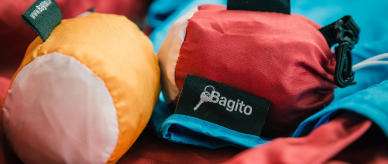Clothing will get worn out one day. There's no avoiding it. Holes will pop up, and our impulse is to throw the garment away, seeing as the only easy fix is something a lot of us don't know how to do. But in this blog, you'll learn the sewing and repairing basics needed to fix your clothing. Repairing clothing is a sustainable practice because, if you weren’t aware, it cuts down on waste. Like I said, the gut reaction to finding a hole in your clothes is to throw it away. We’ve been conditioned into this, because it’s a lot easier to throw something away and buy something new than it is to repair it (or so you think). Sewing is actually really easy to do, once you get the hang of it. And you’re cutting down on your carbon footprint in the process, as you can save on gas that would have been used to drive to the store. So here you have it. Here are the basics you need to fix your own clothing.
Stitches
Now, there are three types of stitches we're going to look at: running, backstitch, and zig zag. These are basic stitches anyone can learn how to do, though some take longer than others.
A running stitch is the most basic stitch that you'll find. It's a simple in and out motion that you can easily replicate if you watch some YouTube videos. It’s the kind of stitch you would instinctively use for sewing, because we see it everywhere in the media, from cartoons to TV shows to movies. The backstitch is a little more time consuming, as it's a type of running stitch where you go back over your work to make sure there aren't any gaps. Lastly, we have the zig zag stitch. Mastering this will definitely require watching YouTube tutorials.
For the stitching, you’re going to want to use 100% polyester thread. This is because it has some stretch to it, and that’ll work for fabrics that also have a little stretch to it. Only use cotton thread if you’re working with cotton garments. This is because you want to match the type of thread you use to the type of fabric you’re sewing.
Patches
Another option, besides just sewing the hole closed, is to sew a patch over it. This will require your basic running stitch, so it shouldn't take too much effort. This is great for repairing things like jeans and flannels. We have patches available for that, if you're interested in adding a little bit of flair to your outfit.
Patches are great for when you want to conceal something but don’t have the skills to mend it traditionally or are in a hurry.
Visible Mending
This form of mending is great if you want to show off your sewing skills. It is the art of stitching patterns onto fabric in a way that makes it unique. You can do all sorts of geometric patterns or shapes. Even as a beginner, it’s a fun way to work with torn fabric. For example, you could sew a star over a hole.
Darning
Typically used for socks, this method is a kind of homemade patch. You create a base of stitches in order to fill in the hole. There’s no real pattern to it, just a hodge podge of stitches that when they come together, make a sort of patch for the garment.
Repair Shops
If you’re unable to repair the garment yourself, repair shops are a great solution. They have the necessary skills needed in order to fix and mend anything you might bring in. While it probably costs less to DIY it, repair shops can help you out with garments that require more skill to fix.
- New York, New York repair services: DejaVu Tailoring, Alts, About the Stitch
- LA repair services: MH Tailoring and Alterations, Dorcas Tailor Shop, Marin Tailor Shop
- Chicago repair services: Frank’s Alterations and Tailoring, Great Looks Tailoring and Alterations, European Tailors and Cleaners
Other Solutions
To round things off, there is repair tape. It's a strip of plastic that is melted down using an iron. This works best for hems. It is very simple to use. Just fold over the fabric onto the tape and iron away. Obviously, this is more of a last resort. You want to steer clear of plastic products, as they are harmful to the environment. That’s why you can also turn to fabric glue. It will hold for a really long time and won’t go brittle over the years. This is another solution that doesn’t require sewing, though again, sewing is the better option. It’s a skill you can use for the rest of your life, so make the effort to learn it. You won’t regret learning something new, and it’s the eco-friendly solution to all of your clothing needs.













